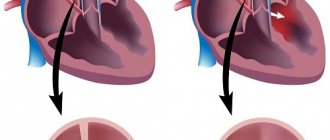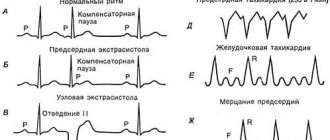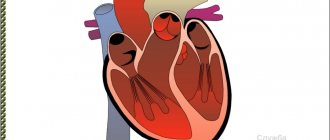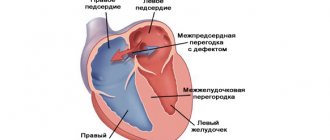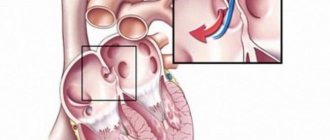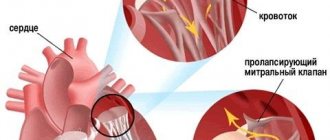Congenital heart disease is considered a generalized pathology and can manifest itself in different forms with different clinical pictures. The question of whether people with congenital heart disease are accepted into the army cannot be given an ambiguous answer. The medical commission makes a decision on the suitability of a conscript with congenital heart disease based on medical certificates and medical history. A citizen of military age receives exemption from the army if he has a second functional class. This type of pathology is revealed by symptoms incompatible with military service and dysfunction of internal organs against the background of congenital heart disease.
Will people with heart defects be accepted into the army in 2020?
Heart disease is always associated with danger and severity of the patient’s condition. It is impossible to even imagine that people with certain types of this disease are legally recruited for military service. However, officially, congenital heart disease is not a disease that prevents service in the Armed Forces.
And in 2020, heart disease is a general diagnosis and only young men with specific forms of the disease can apply for the non-conscription category.
Heart disease is a general diagnosis and can be understood as various physiological changes and diseases that can lead to heart failure. Most often, defective functioning of the mitral valve, aortic stenosis or ventricular obstruction are recorded. Some of these pathologies, to a certain extent and in a specific functional class, are assessed as life-threatening, incompatible with physical activity and overexertion of the disease.
The examination is carried out in accordance with Article 42 of the Schedule of Diseases.
Congenital heart defect
Heart disease is often accompanied by heart failure. There are four main functional classes:
- The first functional class is characterized by the fact that the patient does not experience serious changes. He may be limited in physical activity to some extent, but there are no compelling arguments for exemption from service. A conscript with this type of pathology belongs to fitness category B and will serve in the army with certain restrictions;
- the second functional class is characterized by the presence of certain complications. If the conscript’s health condition falls under this group, he receives fitness category B and is enlisted in the reserves;
- the third and fourth functional classes involve the complete release of a young man from service and the provision of a military ID card for health reasons.
The regulatory document Schedule of Diseases includes an article according to which the emphasis can be placed not on the disease, but on possible complications and consequences if the patient’s regimen is violated. Some of the diseases indicated in the document can progress and develop into independent pathologies, becoming the reason for release from service and enrollment in the reserves.
Mitral canal prolapse. This is one of the congenital heart defects. Currently, a distinction is made between primary and secondary MVP. The causes of the primary type of disease are heredity and congenital pathologies of connective tissue. The causes of the secondary type of disease are rheumatism, inflammatory heart disease, chest injuries and other pathologies.
There are 3 degrees of pathology. The higher the degree, the greater the deflection of the valves during heartbeat.
In the first degree of the disease, no serious changes are recorded. The disease may remain invisible and not cause much discomfort. UPS of this form cannot serve as a reason for exemption from the army.
The second and third degrees can lead to deterioration of the valve. At these stages, regurgitation is observed, that is, pathological changes in the direction of blood flow. The condition leads to serious impairments and problems. The patient experiences oxygen deprivation, rapid heartbeat, and dizziness. If you have a secondary military certificate of 2 or 3 degrees, the conscript receives category B and is enlisted in the reserves.
Pulmonary valve stenosis. There is a narrowing at the site of the valves that regulate the flow of blood from the right ventricle to the pulmonary artery. This leads to the heart working harder. The heartbeat increases to force blood through the narrowed gap. This anomaly accounts for 10% of heart defects, and a conscript with such a defect receives exemption from the army (category B).
Transposition of the great vessels. The pathology is revealed by a violation of the location of the pulmonary artery and aorta, which, as a result of exchanging places, are connected to the wrong chambers of the heart. CHD causes the organs to receive blood that is not sufficiently saturated with oxygen. The patient complains of rapid heartbeat, rapid fatigue, cyanosis, and deformation of the nail plates. A conscript with such a pathology receives exemption from the army.
Fitness for service with additional chords
The formation of an additional chord in the cavity of the left or right ventricles is often either asymptomatic or the symptoms are mild. Therefore, as with the diagnosis of MVP, patients often learn about disorders only during a planned visit to a cardiologist.
There is no article in the Schedule of Diseases that addresses additional chordae. For this reason, the diagnosis of MARS and the army are absolutely compatible. A conscript will be able to be released from service only if there are serious problems with his heart.
Advice from the Recruit Help Service:
The decision to call for minor anomalies should be made only after additional examination by a cardiologist. To receive a referral, you need to provide the military registration and enlistment office doctor with documents from a state medical institution confirming your diagnosis.
Acquired heart defect
Up to 90% of acquired defects develop against the background of rheumatic diseases. Based on the state of general hemodynamics, compensated, subcompensated and decompensated defects are distinguished.
Valve defects cause increased load on the corresponding parts of the heart, myocardial hypertrophy and ultimately heart failure. The suitability of a conscript with an acquired heart defect is determined according to the functional class based on the document Schedule of Diseases.
The clinical picture of the disease depends on the affected valve or combination of affected valves. The patient complains of tachycardia, shortness of breath, edema and other signs characteristic of heart failure.
The main type of treatment for acquired defects is surgery.
Do they take into the army with a bicuspid aortic valve?
Bicuspid aortic valve is a congenital heart defect. According to Article 42 of the Schedule of Diseases, congenital heart valve defects in the absence of heart failure (point c) are grounds for exemption from the army with the assignment of fitness category B.
If a bicuspid aortic valve is diagnosed, then to be exempt from conscription, the heart defect must be accompanied by aortic regurgitation (clause d, Article 42). If a young man is diagnosed with a bicuspid aortic valve without signs of aortic regurgitation (point d), he is assigned conscription category B (military service with limited choice of troops).
Mitral valve prolapse
In the presence of mitral valve disease (MVD) of the 1st degree, the characteristic symptoms of the disease are often absent. The patient's health remains satisfactory. The answer to the question of whether people with congenital mitral valve disease of the 1st degree are recruited into the army is positive. PMH of the first degree is not one of the diseases that exempts you from the army. At the same time, the accompanying documents indicate the relevant information about the presence of mitral valve disease in the young man.
In the presence of mitral valve disease of 2 or 3 degrees, oxygen starvation may occur. It may be accompanied by the following adverse symptoms:
- feeling of fatigue;
- dizziness;
- cardiopalmus.
A young man who has been diagnosed with stage 2 or 3 mitral valve disease is in most cases assigned category “B”. This means that the young man is exempt from military service in peacetime. A young man is subject to conscription only in the event of general mobilization (during military operations).
How to identify a heart defect
The specialist begins determining the presence of a heart defect with a conversation with the patient, the purpose of which is to clarify the existing symptoms. The main signs of the disease include:
- decreased ability to work and rapid fatigue;
- chronic fatigue, fainting, which have been observed since childhood;
- pallor, cyanosis of the skin;
- swelling;
- unstable blood pressure (high or low);
- shortness of breath with little physical activity;
- decreased immunity, provoking the development of various immune pathologies.
With congenital heart disease, the clinical picture is observed from childhood. When compiling an anamnesis, previous diseases and diagnoses, as well as surgical interventions, are taken into account.
To identify heart pathology, it is mandatory to measure blood pressure, study the condition of the skin, and listen to the heart. If necessary, to confirm the preliminary diagnosis, the patient is prescribed instrumental examinations:
- Electrocardiography. The method is effective for identifying various cardiac pathologies. The method makes it possible to record electric fields that arise during myocardial oscillations, which makes it possible to record deviations in the functioning of the heart.
- X-ray. The method allows you to determine anomalous phenomena visually.
- Ultrasound of the heart. Used when necessary to monitor the patient's condition.
The results of the examination are entered into the medical history, which the patient, along with various certificates and a doctor’s opinion, provides to the military medical commission to obtain a deferment or exemption from service due to health reasons.
How does the pathology of MARS progress?
This process is called an anomaly because the structure of the heart differs from normal. And they are called small because these changes do not cause disruption of the hemodynamic process.
Expert opinion
Antonov Viktor Sergeevich
Practicing lawyer with 8 years of experience. Specialization: military law. Recognized legal expert.
MARS implies a pathology in the formation of connective matter, which is considered the framework for cardiac structures. Connective matter plays a significant role not only in the structure of the heart, but also in other organs.
For this reason, if more than three MARS are present at the same time, it is necessary to examine the person for the presence of connective tissue dysplasia with the formation of disorders in other organs.
This is important to know: How to restore a passport without documents
Recently, the detection of minor cardiac anomalies has become more frequent: this is not associated with an increase in their absolute number, but with the introduction of echocardiography, which has become more accessible. MARS has a fundamental difference from heart defects. Anomalies do not affect human life in any way.
How does pathology occur in young people?
- With minor physical exertion, a feeling of palpitations, fatigue, and pain in the heart area occurs; sensations of cardiac arrest;
- Signs of disorders of the vegetative-vascular system may be observed: fainting, dizziness, weakness, increased sweating, and others.
Typically, the presence of signs can only be traced by combining several small anomalies at once. If there is a combination of more than three minor anomalies, shortness of breath, arrhythmia and symptoms of congestion (swelling, increased liver size) are likely to occur, since there is a disturbance in the blood circulation.
How to get a deferment or exemption
To receive a deferment, a conscript must submit to the military registration and enlistment office a medical document that proves that he has a congenital or acquired heart defect that requires treatment both conservatively and surgically. The basis for a delay may also be evidence that the patient is undergoing a rehabilitation period after heart surgery. After the expiration of the recovery period, the conscript appears at the military registration and enlistment office and undergoes a second examination. If it is determined that health is fully restored after the operation, then he is sent to serve in the Armed Forces.
To receive exemption from the army under non-conscription category B, a conscript must have functional class 2, 3, 4 heart failure, severe heart rhythm disturbances, blood flow conduction failure, 2 and 3 degrees of mitral canal prolapse.
Congenital heart disease cannot be a reason for exemption from military service. To receive a non-conscription category or deferment, a conscript must prove the presence of a heart pathology that corresponds to a specific paragraph of Article 42 of the Schedule of Diseases.
Characteristic features of pathology
An ASD involves the septum that divides the atria into two chambers containing an opening.
During the development of the fetus, it is necessarily present, since it contributes to normal blood circulation. This patent foramen ovale closes after birth in most people, although sometimes it does not. Discharge through an open window in adulthood is insignificant, and therefore its effect on the life activity of a conscript is weak. However, along with the situation of non-fusion, there are so-called true defects in the septum. They can be in different zones. In this case, there is a shunt, and the blood is discharged from the left side to the right.
This movement of blood occurs with every contraction of the heart. This causes the right chamber and lungs to overflow with blood. The pulmonary vessels also encounter its excess. Therefore, conscripts have a history of frequent pneumonia and heart complaints. To eliminate the defect, surgical intervention is required, since its natural healing is impossible.
An ASD involves the septum that divides the atria into two chambers containing an opening. During the development of the fetus, it is necessarily present, since it contributes to normal blood circulation. This patent foramen ovale closes after birth in most people, although sometimes it does not.
Discharge through an open window in adulthood is insignificant, and therefore its effect on the life activity of a conscript is weak. However, along with the situation of non-fusion, there are so-called true defects in the septum. They can be in different zones. In this case, there is a shunt, and the blood is discharged from the left side to the right.
This movement of blood occurs with every contraction of the heart. This causes the right chamber and lungs to overflow with blood. The pulmonary vessels also encounter its excess. Therefore, conscripts have a history of frequent pneumonia and heart complaints. To eliminate the defect, surgical intervention is required, since its natural healing is impossible.
Reviews
Dear readers, was this article helpful? What do you think about serving in the military with a congenital heart defect? Leave feedback in the comments! Your opinion is important to us!
Marat
“I have had heart problems since childhood. When I was called for a commission at the military registration and enlistment office, I presented all the documents that proved that I had a serious heart defect with circulatory problems and significant heart failure. As expected, they assigned category B.”
Valentina
“My son was diagnosed with a bicuspid aortic valve. They thought that with such a heart defect they would be released from the army. However, the commission decided that he would serve in certain troops (category B), since he does not have a blood flow disorder.”
